04. Small Boat Setup
Between The Lines - Ch10: Boat Setup
To a large extent, what is considered to be a small boat is relative to the boats you are used to. If you have spent time on a 12-foot bass boat, a 21-footer will seem palatial. A twin-diesel 30-foot fly-bridge game boat will seem tiny and just too small to go to sea if you are accustomed to a 50-foot cruiser. Regardless of boat size, the goal is to make functions as easy as possible so the boat works as an effective tool.
There is nothing on this planet more exciting than catching fish that are relatively large compared to the boat you are in. (Fig 1) Just as many other things in life, it's not the size that counts, but how you use it.
Small boats are fun, but they cannot safely handle the same sea conditions or bar crossings as larger boats, nor do they have the range of big boats, due mainly to a lack of fuel-carrying ability - although newer technologies have increased this considerably. Nor do small boats have the comfort of larger ones.
There are many factors that make pocket game fishing boats desirable. The initial outlay is a fraction of that for larger boats, and transporting them on trailers towed by the average car allows you to easily and cheaply follow the fish along the coast throughout the season. Maintenance is also much cheaper than on larger moored boats, and crew size is also another factor - on larger boats you need at least three, realistically four crew if you're using chair rods. In contrast, on small boats two or three is plenty; and if set-up correctly, solo fishing is even an option. (Fig 2)
 Fig 1 Fig 1 |
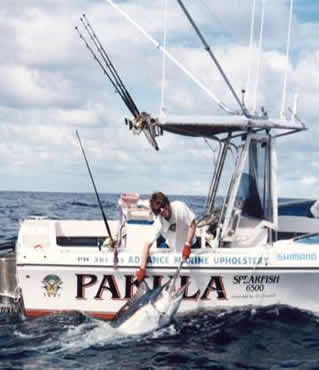 Fig 2 Fig 2 |
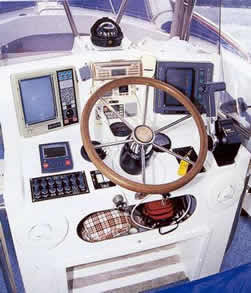 Fig 3 Fig 3 |
 |
Setting up a small boat is no different to setting up a bigger one. Essentially, the fish you are chasing and many of the areas you fish are the same. To achieve the same result as a larger boat, you should look at a set-up that is as similar as possible. This is not hard to achieve, but it's important to eliminate the mindset that 'little' boats need smaller, cheaper accessories. The console and electronics set-up on my current 30-foot boat, Animal is similar to my previous boat which was a 21-foot Spearfish and very similar to my even older 14.5-footer Cockroach.
The 21-footer's console (Fig 3) contained a 2OOmm, 6OOW colour sounder with temp tracking graph, a 200mm chart plotter, VHF and 27MHz radios, CD player, trim-tab control, autopilot, fuel usage gauge, fridge, plus power outlets for cameras, phones, etc. Apart from the overall length, the Spearfish was equal to many of the larger boats it competitively fished against. In other words, a serious fishing boat needs serious tools -whatever its size. In the case of sounders, they should be colour with a speed and temperature sender both of which should be calibrated. Your GPS should be a chart-type where it's simple to register way-points and event marks so that marking bait schools, hook-ups and logging 'signs' can be done with a minimum of fuss. The screens and buttons on the electronics should be large enough to see and use in relatively bumpy conditions. Certainly, great advancements will continue in sounder and GPS daylight viewing and practical ease of use. High pixel count and definition plus fast zoom makes analysing bait schools easy. With chart plotter and upgradeable software are a major advantage when choosing sounders.
EPIRBs, life jackets and other safety gear should be mounted within easy reach. When things go wrong, as they can on any size of boat, the electronics are the command centre. On both Cockroach and the Spearfish, the life jackets and flares were kept in a pocket underneath the T-top for easy access. (Fig 4)
To aid in fighting fish, hydraulic steering should be considered. To make life even easier on small boats, a simple autopilot is worth the investment. Both these features free up the skipper (possibly solo) to enable the setting and adjustment of lures and fight fish without the boat going into a tight turn as soon as they let go of the steering wheel.
Lure and tackle storage should be considered in two parts. Storage for gear not being used which may be in trays, roll-up bags (Fig 5) or tackle boxes and storage for gear that is cleared out of the way during a fight, usually in a fish bin or tray. (Fig 6)
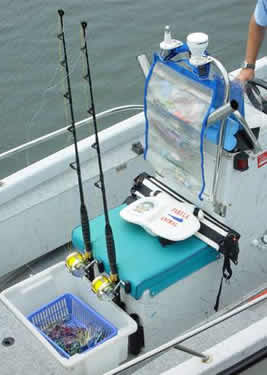 |
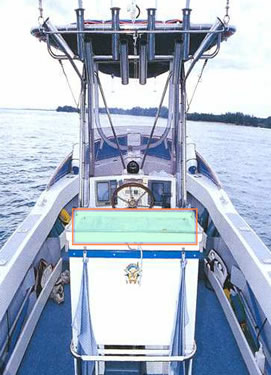 |
| Fig 5 | Fig 6 |
Equipment that may be needed such as pliers, knives and hook removal tools should either be placed in a handy position or worn on a belt so that they are easily accessible when needed.
Handling fish at boat-side also needs consideration with added cleats and duplicating tools such as tag-poles, bill ropes, gaffs on both sides of the boat so that they are at hand when needed. (Fig 7)
 |
| Fig 7 |
On smaller boats, with less crew, each member needs to be more self-sufficient. The angler should get the gimbal and harness on before removing the rod from the holder. To make this easier they should be pre-adjusted and the angler trained to make any further adjustments without assistance. These items should also be ready and within easy reach.
Trolling gives the ability to use several lures at the same time offering fish a great selection with which to tempt a strike. Many anglers get quite carried away with offering as many choices as possible, with some trolling ten or more rods in a single spread. Apart from confusion when one gets a strike, and the need of experienced crew, boats trolling that many rods don't seem to catch any more fish than boats trolling the more controllable four or five rods.
There are a number of factors to consider when positioning rod holders. You need them to be positioned for effective trolling and lure placement to maximise the spacing and number of rods you can troll. With the correct set-up, trolling up to eight rods out of any size of boat is quite possible. (In reality, four to five is quite sufficient.) You also need to consider that when you hook-up on a decent fish, all the other rods have to be stored (Fig 8) out of the way of the angler and crew. Some of the holders may serve both as trolling and storing positions.
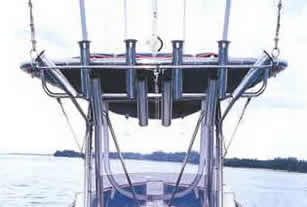 |
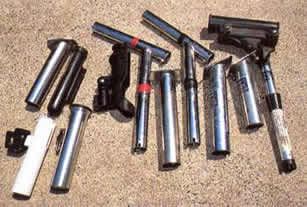 |
| Fig 8 | Fig 9 |
Setting up rod holders should be considered in three dimensions, with the aim of spreading the rod tips as far apart across the back of the boat and as far apart in height on the boat. For trolling, however, the rods should be grouped as close as possible along the length of the boat - generally towards the back.
Rod holders are available in many configurations - straight, angled, long, short, through-mount, surface-mount, rail-mount and custom-angled. With thoughtful positioning, a small boat can be set-up to be more efficient than many larger cruisers. (Fig 9)
Care regarding the positioning of the rod holders results in the ability to run more lures which in turn offers the target species more choices. The careful positioning in spreading the lures is to enable the boat to turn without tangling the lures, and so that a crosswind and sea do not blow the lures into each other, causing tangles. Rod Holders should also be positioned so that the lures are run outside the prop wash which is quite turbulent and causes lures and rigs to spin more than they do in clearer, cleaner water.
Even if you are only setting up your boat to troll a few rods, you should consider placing the holders so that you can add more over time without having to reposition the ones installed.
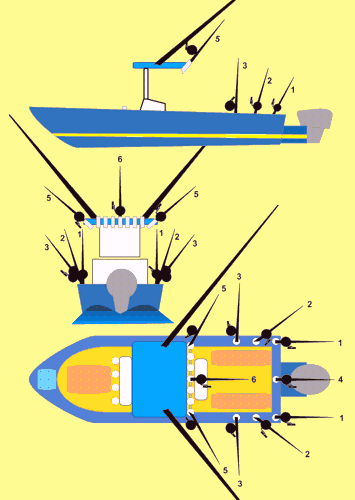 Fig 10 Fig 10 |
1 - Long-angled rod holder short positions. The image (Fig 10) shows a complex configuration that would allow you to troll eleven rods out of a small boat at any one time, plus have storage positions when travelling or fighting fish! Such a set-up would be considered going overboard, thus the main holders to consider are:
2 - Long-angled rod holder mounted at 45 degrees. Note: When mounting a holder at an angle the gimbal pin should ensure the rod points straight back so that the line comes straight over the top of the tip guide or roller (Fig 11) and not off its side which may damage the line. (Fig 12 and 13)
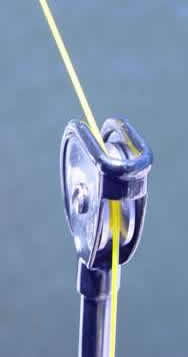 |
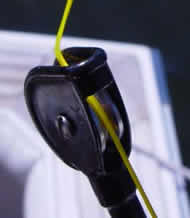 |
| Fig 12 | |
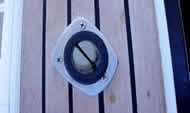 |
|
| Fig 11 | Fig 13 |
3 - Short-angled rod holders set at 90 degrees (pointing straight out). Using a shorter holder here makes the rod tip a little higher than the others do in the gunwales to aid tip clearance.
4 - Long-angled rod holder centre position.
5 - Bimini or T-top end rod holder set out at an angle of 45 to 60 degrees. By using this position, the problem of setting up outriggers each time you go out on a small boat is virtually eliminated. (Fig 14)
6 - The shotgun position is easily solved by utilising the rocket launcher. The bimini or T-top 'rocket launcher' should be constructed sturdy enough to cope with being used as rod holders. The rocket launcher should only be used to run lures or baits on and store rods out of the way when fishing. Rod storage should leave the gunwales clear for action. Rods should also be stored out of the way of spray when travelling. (Fig 15) It is also desirable to remove all terminal tackle when travelling, as hooks invariably free themselves and swing around to tangle or ensnare whatever or whoever is within reach.
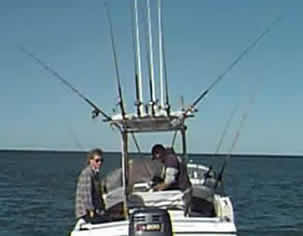 |
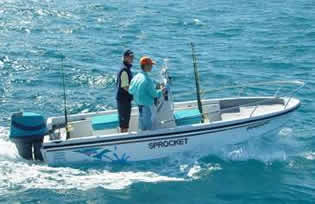 |
| Fig 14 | Fig 15 |
The pressure on rod holders during a strike can be massive. All rod holders in the gunwales should be bolted using nylock nuts and oversized washers. Heavy-duty stainless steel or chromed brass holders can generally cope with the stresses. Most plastic ones will not, especially if considering using line classes of 15kg and above. The use of safety lines should be considered on all trolling rods until you are confident that your boat's rod holders can cope with repeated loading from strikes; that the rods won't fall out of rod holders in rough seas, tight turns and that your anglers can remove rods from the holders without dropping them over the side of the boat!
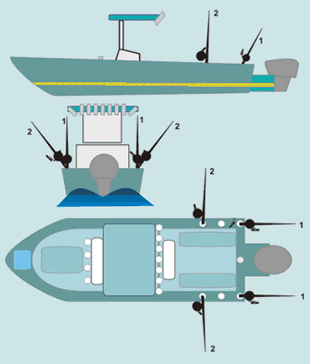 |
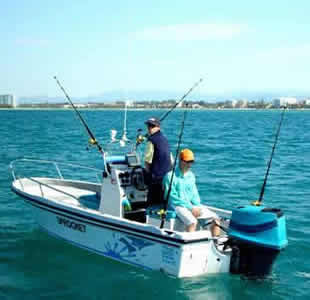 |
| Fig 16 | Fig 17 |
Let's now consider a classical two-rod-per-side set-up. (Fig 16) The shortest lures are run from rods, numbered 1 at the back of the boat. The lures that are set back further are run from the rods at the side of the boat, numbered 2.
Another version of this is using rod holders on the grab rail to position the rods higher, almost in a semi-outrigger position without the fuss. (Fig 17)
Rod-rigger holders can also be utilised to maximise the spread. The great variety of possible angles make these holders very versatile. (Fig 18 and 19) Note the use of safety lines.
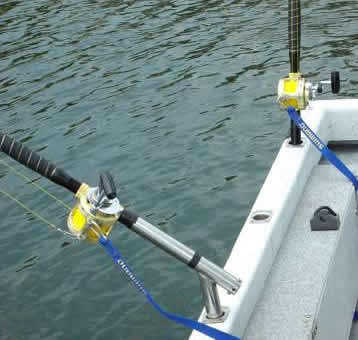 |
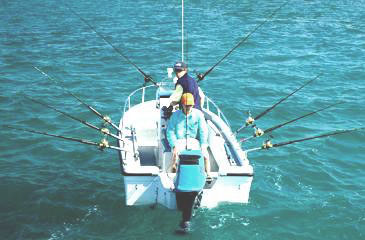 |
| Fig 18 | Fig 19 |
The many different types of holders on the market, plus the ease of getting custom holders made, allows the freedom to set-up any configuration you can imagine, regardless of boat size. Although there is plenty of room to spread the holders, it is an advantage to group them together alongside the steering helm. Not only can they all be checked with a single glance and are easy to reach while driving, but because they are 'tight', it allows you to position multiple lures, while still being able to put the boat into a tight turn with a minimal chance of tangling.
As much consideration should be given to rod storage as allocated to positioning anything else in the boat. When fighting fish, it is desirable to have all sides of the boat clear of rods and other paraphernalia that can get in the way.
Outriggers on small boats pull the same lures as bigger boats in the same area using the same release tensions, yet it is quite difficult to find outriggers for small boats that are not sloppy and ineffective. The use of stays (Fig 20) to help stiffen them is usually necessary as is extra strengthening around the mounting points. The subject of outriggers has been previously covered where all the points mentioned are just as relevant to small as to larger boats.
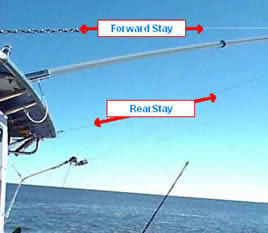 |
| Fig 20 |
A boat may be small, but if it is rigged and set up like a big boat it can easily match the results as well. Often the reason larger boats out-fish smaller ones are that the crew is larger and has a greater pool of experience available. In fact, most of these 'successful' crews have done much of their time gaining experience and having fun on smaller boats.





